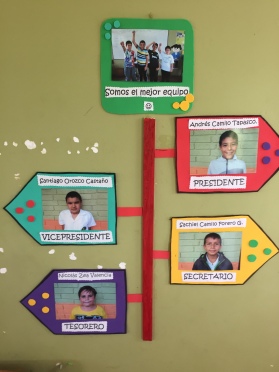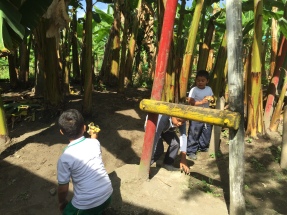 Student choice, collaboration and differentiation. These are all things that I work to facilitate in my teaching. It was both exciting and inspiring to see these strategies in practice at a group of rural schools that I was able to visit this week. These schools were run on the innovative Escuelas Nuevas teaching model. This model has received international recognition and was recently featured in two articles in the New York Times: Make a School A Democracy By David Kirp and Children Thrive in Colombia’s Rural Schools by Sarah Hamdon . As luck would have it, our host teacher Nancy Echeverri has done research on these schools and was able to arrange for our visits.
Student choice, collaboration and differentiation. These are all things that I work to facilitate in my teaching. It was both exciting and inspiring to see these strategies in practice at a group of rural schools that I was able to visit this week. These schools were run on the innovative Escuelas Nuevas teaching model. This model has received international recognition and was recently featured in two articles in the New York Times: Make a School A Democracy By David Kirp and Children Thrive in Colombia’s Rural Schools by Sarah Hamdon . As luck would have it, our host teacher Nancy Echeverri has done research on these schools and was able to arrange for our visits.

The Escuelas Neuvas model was created by a Colombian educator in the 1970’s as a way to improve the education of rural children. The idea was to create a model that would allow one teacher to teach multiple grades. At the Sede Corinto IE Caimot school, one teacher, Embera Chami was teaching a class of 20 kids ranging from Kindergarten to 5th grade.
How does this work? A central component of this model is the fact that much of the learning is student directed. At each of the schools we visited we were greeted by the student leaders. These leaders are elected by their peers and are responsible for taking attendance, creating and enforcing class rules and helping to design projects. At each of the ta bles where the students were working, there were also “leaders”–students responsible for facilitating the day’s learning. Even a kindergartener proudly introduced himself as his table leader and was able to explain the task for the day and what needed to be done!
bles where the students were working, there were also “leaders”–students responsible for facilitating the day’s learning. Even a kindergartener proudly introduced himself as his table leader and was able to explain the task for the day and what needed to be done!
The Escuelas Neuvas curriculum was designed to allow students to work with minimal teacher support. It incorporates hands-on projects that could be done using readily available materials. Because all Escuelas Nuevas schools use the same curriculum, a student from a migrant farming family can pick up where they left off, regardless of where they were before. The title of the book is Aprender a Aprender which means “Learning to Learn.” From what I observed this is exactly what these kids were doing!

The lessons are based on “hands on” activities and kids were doing different activities all around the room. At one table a group of kindergarteners was completing a puzzle. At another table a group of 2nd graders were learning how to use Cuisinare rods to learn pre-multiplication concepts. At yet another table a group of 3rd graders was deciding who would bring materials that they would need to do an experiment the next day. When one student was wandering out of his seat other students directed him back to his learning. The teacher moved around the room until she came to a group of 4th graders who had just started a lesson on coordinate grids. She showed them how to use a chess board to play a game that was described in their books. Some of the groups included students of different grade levels if they were able to do the content of that lesson.
It was easy to forget the challenges that most of these students dealt with in their daily lives. Most of their parents worked on the surrounding coffee farms–work that involved long hours and very low pay. Their teacher explained that many of the children walked an hour each way to school each day. Many had parents who did not read or write. Students often abruptly left the school for periods of time.
 But the statistics are on their side. The students in the Escuelas Nuevas model consistently outperform their peers who are at traditional schools. In fact at one school we visited, a student’s parents were professors at a local university. They chose to place their son in a rural school because they recognized the value of this model. With very limited resources teachers are able to deliver high quality instruction, teaching their students not only how to learn, but to love to learn!
But the statistics are on their side. The students in the Escuelas Nuevas model consistently outperform their peers who are at traditional schools. In fact at one school we visited, a student’s parents were professors at a local university. They chose to place their son in a rural school because they recognized the value of this model. With very limited resources teachers are able to deliver high quality instruction, teaching their students not only how to learn, but to love to learn!
I felt so lucky to see this model in action and to get to speak with Embera Chami about her teaching practice. When I asked her if she liked working in the rural schools her answer was clear –her face beamed with a broad smile. Just like that of most of the students that I met!
QUESTION FOR KIDS: The students at the Sede Corinto IE Caimot school learn in a “one room school”, with all grades working together. What would you like about going to a school like this?
What questions do you have for the students of a rural school?



Wow! I’m so happy you got to see this in action. I’ve been reading about a similar model of solving STEM problems. They’ve learned that students who have “teachers” who know very little about the topic actually do better than those students who have more learned teachers. Apparently, the learned teachers are too likely to give assistance and too much guidance. Very
LikeLiked by 1 person
So interesting Stacy! Be sure to read Ryan’s blog also– he goes into a lot of detail about this. Big message /lesson : just get out of the way! So hard to do!!!
LikeLike